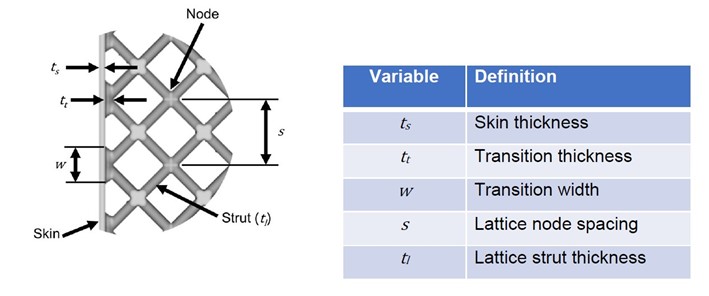


Lattice variable illustration and lattice to skin design variables that are being investigated for the mechanical performance of the lattice to skin transition.
Problem
Complex cellular and lattice structures are an exciting field of materials development offering revolutionary opportunities in medical devices, light-weighting, and impact protection. The design freedoms offered by additive manufacturing (AM) are uniquely suited for producing lattice structures. There has been a synergistic development cycle between the lattice design and AM communities, but there is an unmet need to understand how the lattice structure integrates with surrounding skin or thin wall material.
Objective
The objective of this program was to establish best practices to successfully design and integrate metal lattice structures with a part boundary region such as a thin wall or skin material. A further objective was to develop a design and testing toolkit to enable designers to make better informed and higher performing parts and devices which utilize lattice structures.
Technical Approach
The Ohio State University (OSU) led the technical effort which included 3Degrees, Elementum, and Lockheed Martin. The researchers explored a range of geometric parameters which influence the transition region. Tensile specimens were designed and simulated using nTopology, building off work previously performed by OSU’s Center for Design and Manufacturing Excellence (CDME) on another America Makes project (Tensile Behavior of AM Lattice Structures). The best performing designs were printed on the CDME’s Concept Laser M2 using the Elementum A7050 aluminum material. Mechanical testing of these samples was performed at the OSU Dynamic Mechanics of Materials Laboratory (DMML) using 3D Digital Image Correlation (DIC) and other methods. The results of the testing were then used to design and print a demonstration component relevant to industry applications. All project data was managed for implementation with 3Degrees TRACEam software.
Accomplishments
Simulations were performed to better understand the lattice to skin transition strategies. These simulations served as a preliminary screening task to ensure the successful creation of the manufacturing builds. The three transition strategies that were selected proved to be effective in providing a range of test results and understanding of actual part performance. Physical tests were conducted and highlighted some trends of interest at the lattice skin interface. A demonstration component (satellite bracket) was selected to monitor part performance during and after a vibration test. Vibration testing is one important evaluation criteria for some light weighted components, making it vital that the project team was able to achieve this. Furthermore, both high and low frequency vibration modes are often evaluated to simulate launch and orbit in the space industry. Finally, after vibe testing a CT inspection of the part was performed in search of gross defects. Overall, limited/no strut breakages were found.
Project Participants
Project Principal

Other Project Participants
- 3Degrees
- Elementum
- Lockheed Martin
Public Participants
- U.S. Department of Defense
- U.S. Food and Drug Administration
